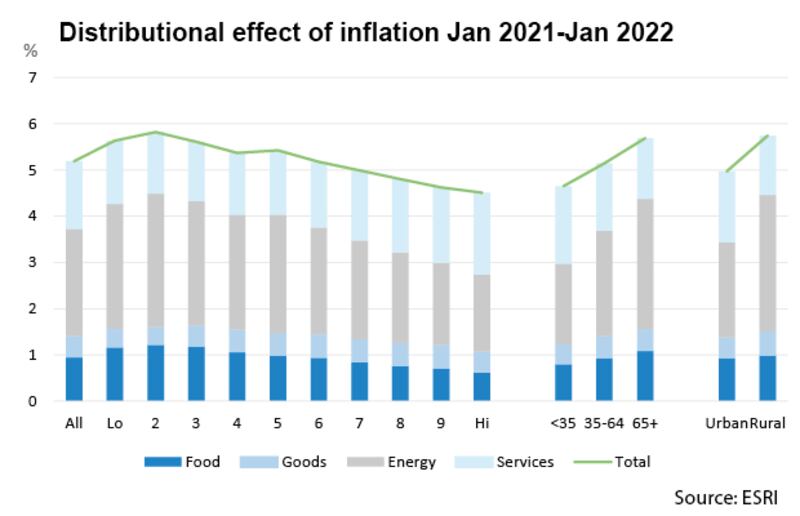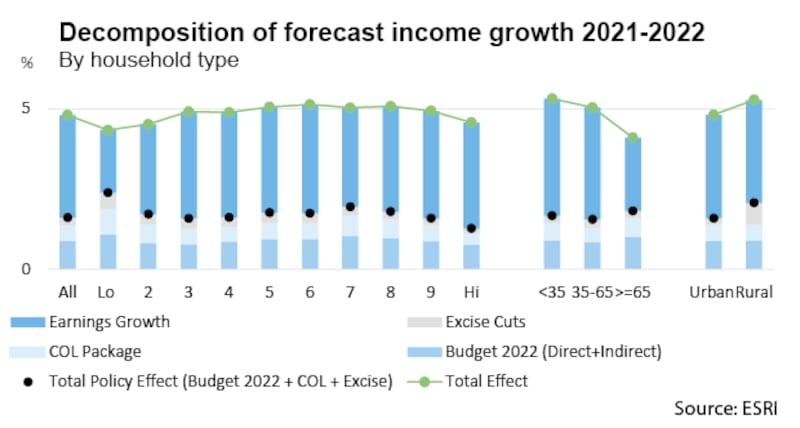The purchasing power of Irish households will fall this year for the first time since the period after the 2008 financial crash.
Back then, the fall in purchasing power between 2008 and 2012 was due largely to a drop in disposable incomes as unemployment soared, earnings fell for many and taxes rose sharply.
Now the cause is different. Incomes will rise this year, but this will be outstripped by a big jump in the rate of inflation.
The latest ESRI quarterly commentary looked at the outlook for living standards for different types of households this year – and showed significant gaps in the extent of the hit across different groups in society.
Everyone is caught in the cost of living crisis, but some will fare worse than others.
1. An unequal hit: Higher prices hit all households, but some suffer more than others. Analysis developed by Central Bank economist Reamonn Lydon last year was updated in work published with the latest ESRI quarterly economic commentary and built on with new analysis.
ESRI economists Karina Doorley, Mark Regan and Barra Roantree looked at the inflation data for January, which showed an annual inflation rate of 5.2 per cent in January.
Looking at the different spending patterns of households, they calculated that those who would face the highest inflation rate would be poorer households, older households and those in rural areas.
These three types of households share one key characteristic – they spend a high proportion of their income on energy. Richer households may spend more in cash terms, but as a percentage of income they spend less, because they have more cash to spend on non-essentials.
Less well-off and older households typically spend significant amounts of their income on fuel for heating and cooking, while rural households generally face higher petrol and diesel bills due to longer journeys to work, school, or to shop.
All generally spend a higher proportion of their income on food, too, and it is also increasing in price.
The differences in the inflation rate experienced can be substantial as shown in the graph from the ESRI research.

In the year to January the poorest households had an inflation rate typically 1.1 percentage points higher than those on the highest incomes (5.8 per cent versus 4.7 per cent).
Rural households had a rate 0.7 of a percentage point above urban ones. And older households had an inflation rate 1 percentage point above younger ones.
Of course, every household has different spending patterns – but these are good indications of where the burden falls.
And with the inflation rate rising, the most exposed households will face a real price shock in the coming months. With the ESRI saying the rate of inflation could peak at 8.5 per cent, it is quite conceivable that households most exposed to fuel could face an inflation rate of 10 per cent or more for a period this year and an average rate for the whole year which could be 8 per cent.
2. 2022 outlook: The ESRI researchers then undertook another different calculation to look at how disposable incomes might rise this year and how this would compare to inflation.

The overall picture is that household disposable income is expected to rise by 4.8 per cent on average this year, compared to 2021.
However, with the ESRI forecasting that inflation could average 6.7 per cent, this implies a reduction of close to 2 per cent in real earnings – in other words in the amount of goods and services which an average income can buy.
And with a possibility that oil and gas prices could rise further, there is a risk of a bigger hit.
The calculation provides an interesting picture of what is driving the increase in disposable income, as shown in the ESRI’s graphic.
The biggest contributor, not surprisingly, is rising earnings which benefits younger and better-off households the most as they have a higher proportion of people at work.
This is followed by last October’s budget, which added 0.9 per cent to disposable income on average, with a larger impact on less well-off and older households and the cost-of- living package announced in January – including the €200 grant, a number of welfare changes and a cut in public transport measures – which added around 0.5 per cent, again with larger effects for lower earners.
Finally the recent excise cut added 0.25 per cent to average disposable income with the greater impact for lower income and rural households.
The sum, so far, still leaves the average household suffering a fall in purchasing power this year.
There are a couple of points to note here. One is that many households built up substantial savings during the pandemic, which will act as a financial cushion. These tended to be better-off households, which were less likely to be exposed to earnings falls experienced in the worst hit sectors during Covid.
The other is that while the researchers had to assume that every working household will benefit from the same earnings growth (bar slightly different figures for employed and self-employed people), in reality we know that there are large gaps here. So some in sectors where pay is surging will get an increase sufficient to offset current inflation forecasts, while some sectors will lag well behind.
3. The big picture: There are a few really key points here which will dominate much of the political and economic debate.
One is what the Government can – and should – do?
For now, having introduced a household package and an excise cut, ministers are sitting tight no doubt waiting to see how events play out and how energy prices develop.
With the likelihood that energy prices will remain high, new measures to support less well-off households, possibly some move on VAT on fuel and some assistance for businesses may all be on the cards. But adding in the cost of dealing with Ukrainian refugees, it is clear that leeway in the budget sums will be quickly used up.
For now, buoyant taxes will help, but if there is a hit to the wider economy these could suffer too going into next year.
The extent of this impact on growth remains very hard to predict, given the uncertain outlook. But the big hit to purchasing power will be a shock to households, after a long period from 2012 to 2019 during which average incomes rose by 30 per cent and inflation averaged just 0.5 per cent a year.
During Covid some households suffered, but the State offered significant protection and many incomes were unaffected. Now there is a hit across the board and the State has less leeway to offer protection in supporting incomes.
As the ESRI pointed out, the war in Ukraine will also hit business confidence and investment and affect Ireland’s export markets.
For now most forecasts expect the Irish and European economies to grow this year, albeit more slowly. Any interruption to energy supplies, however, could quickly pose a threat and would intensify the hit on living standards by pushing up energy prices and possibly threatening jobs and investment.

















